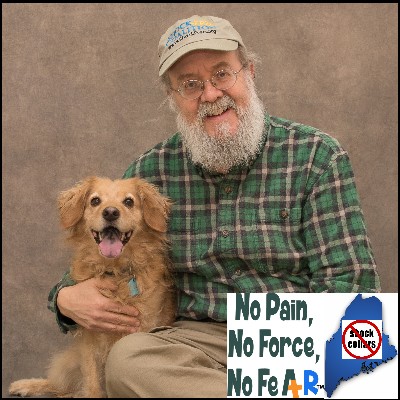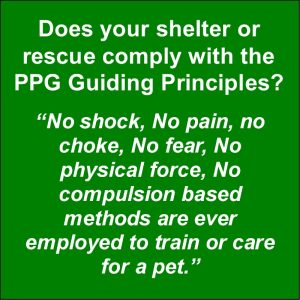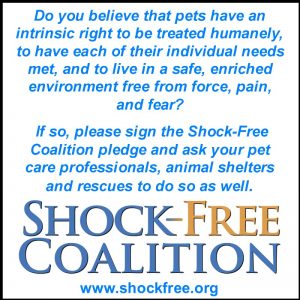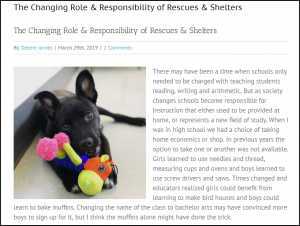< Versions these articles were published in the MAY 2017 and JUNE 2017
Issues of Downeast Dog News>
<Updated 11JUN17>
These articles have been updated since they were published in the Downeast Dog News. I have added material at the end which discusses an incident which occurred in Virginia Beach, VA on June 1st where a 91-year-old woman was attacked and killed by a newly adopted rescue dog with a previous bite history.
What defines a dangerous dog? – Part 1
Last July I wrote the first of three columns addressing dog bites and fatalities after a seven-year-old boy died as a result of an  attack by a dog. For the past few weeks, the news and social media have been abuzz with a rescue dog from the Waterville area (Dakota) that has attacked and killed a dog. This dog was scheduled for euthanasia, has been pardoned by the Governor, then the court reinstated the euthanasia order, and now this case has been appealed to a higher court, which means a final disposition of this case may not happen until this fall.
attack by a dog. For the past few weeks, the news and social media have been abuzz with a rescue dog from the Waterville area (Dakota) that has attacked and killed a dog. This dog was scheduled for euthanasia, has been pardoned by the Governor, then the court reinstated the euthanasia order, and now this case has been appealed to a higher court, which means a final disposition of this case may not happen until this fall.
Dakota’s case has been emotionally charged, and I think it will be to the benefit of all dogs and dog lovers if we look at this case objectively. This is my attempt to do so.
So what defines a dangerous dog? Title 7, Section 3907, 12-D of the Maine statutes defines a dangerous dog as – “Dangerous dog” means a dog or wolf hybrid that bites an individual or a domesticated animal who is not trespassing on the dog or wolf hybrid owner’s or keeper’s premises at the time of the bite or a dog or wolf hybrid that causes a reasonable and prudent person who is not on the dog or wolf hybrid owner’s or keeper’s premises and is acting in a reasonable and nonaggressive manner to fear imminent bodily injury by assaulting or threatening to assault that individual or individual’s domestic animal. “Dangerous dog” does not include a dog certified by the State and used for law enforcement use. “Dangerous dog” does not include a dog or wolf hybrid that bites or threatens to assault an individual who is on the dog or wolf hybrid owner’s or keeper’s premises if the dog or wolf hybrid has no prior history of assault and was provoked by the individual immediately prior to the bite or threatened assault.” [Emphasis added]
The definition above makes it clear that if a dog bites a person or a domesticated animal they meet Maine’s legal criteria of being a “dangerous dog.” In fact, based on the above definition the mere act of exhibiting threatening behavior, without actually biting, would meet the definition of being dangerous. While the law does not specifically address whether or not a dog that kills a person or a domesticated animal is dangerous; it seems that the logical conclusion would be that a dog that kills is extremely dangerous.
The legal community and canine behavior professionals have been using a bite scale developed by Dr. Ian Dunbar for many years. The scale is an objective assessment of the severity of dog bites based on an evaluation of wound pathology. It starts off with Level 1, which is described as “Fearful, aggressive, or obnoxious behavior but no skin-contact by teeth. [Emphasis added]” The Dunbar bite scale is very similar to Maine law which declares that a dog that is threatening may be considered as dangerous.
Dr. Dunbar rates the prognosis of rehabilitating a dog with a Level 1 to Level 2 bite as good and a level 3 bite as fair. However, Dr. Dunbar states that a dog exhibiting a Level 4 bite (a single bite with at least one puncture) is dangerous with a poor prognosis for rehabilitation. Dogs that have bitten at Level 5 (multiple bites and severe mutilation) through Level 6 (the victim is killed) are considered to be dangerous by Dr. Dunbar and have a dire prognosis for rehabilitation. I believe Maine’s law on dangerous dogs could be improved by incorporating Dr. Dunbar’s bite scale.
In this article from 2012, the late Dr. Sophia Yin describes her approach to evaluating dog bites based on Dr. Dunbar’s bite scale. – https://drsophiayin.com/blog/entry/was-it-just-a-little-bite-or-more-evaluating-bite-levels-in-dogs/
FMI – http://www.dogtalk.com/BiteAssessmentScalesDunbarDTMRoss.pdf
If the court finds that a dog is dangerous as defined above, the law dictates that the court shall impose a fine and:
- “Order the dog confined in a secure enclosure except as provided in paragraph C or subsection 8. For the purposes of this paragraph, “secure enclosure” means a fence or structure of at least 6 feet in height forming or making an enclosure suitable to prevent the entry of young children and suitable to confine a dangerous dog in conjunction with other measures that may be taken by the owner or keeper, such as tethering the dangerous dog. The secure enclosure must be locked, be designed with secure top, bottom and sides and be designed to prevent the animal from escaping from the enclosure. The court shall specify the length of the period of confinement and may order permanent confinement; [2011, c. 82, §1 (AMD).]”
- “Order the dog to be euthanized if it has killed, maimed or inflicted serious bodily injury upon a person or has a history of a prior assault or a prior finding by the court of being a dangerous dog; or [2011, c. 82, §1 (AMD).]”
- “Order the dog to be securely muzzled, restricted by a tether not more than 3 feet in length with a minimum tensile strength of 300 pounds and under the direct control of the dog’s owner or keeper whenever the dog is off the owner’s or keeper’s premises. [2011, c. 82, §1 (NEW).]”
- The court may also choose to order restitution to the injured parties.
I love dogs and hate to see a dog lose its life to natural causes or state-mandated euthanasia; however, I also hate to see a person or another animal attacked and even possibly killed by a dog. The fact is not all dogs that exhibit aggression can be rehabilitated and are safe to be rehomed. We need to have equal concern for the community at large as we do for any individual dog.
This case leaves me with questions for which I do not have an answer. If Dakota is released, who will be legally, financially and morally liable for any future aggression by Dakota? The courts, the Governor, those who have evaluated Dakota and insist he will be safe in the future, Dakota’s owner, or all of the above?
Next month I will delve into this issue further, discussing the obligations those that rehome a dangerous dog and the responsibilities of someone who adopts a dangerous dog.
Dangerous Dogs – Part 2
Responsibilities of Shelters/Rescues, Prospective Dog Owners, and Dog Owners
Last month I discussed the definition of a dangerous dog as defined by Maine state law. I also described the bite scale developed my Dr. Ian Dunbar. I use the Dunbar bite scale when assessing the severity of a bite as do other canine behavior consultants and attorneys. As I indicated last month, per Maine law and Dr. Dunbar’s bite scale, a dog that merely threatens can be considered dangerous and can be classified as a dangerous dog.
Shelters/Rescues
I appreciate the effort made by shelters and rescues to find homeless and wonderful dogs a new forever home; however, I believe that first and foremost, shelters and rescues have a responsibility to act in the best interest of their local community. That means:
- Management and all employees and volunteers responsible for adoptions have been trained on Dr. Dunbar’s bite levels as well as Maine state law covering dangerous dogs.
- They have, and they follow, detailed written policies on the adoption of dogs with a bite history that indicate when and why they will adopt and when and why they will not adopt.
- They provide full disclosure of any bite history or behavioral issues with any dog they adopt. They NEVER fail to disclose information, such as a bite history, in an attempt to make a dog more adoptable.
- If a dog in their care has bitten at level 3 or greater, they will not make that dog available for adoption until they have the dog evaluated by a veterinarian, with behavioral experience, that is independent of their organization. Additionally, they will consider having these dogs evaluated by a dog behavior consultant credentialed by; the Animal Behavior Society (ABS), the International Association of Animal Behavior Consultants (IAABC), or the Pet Professional Accreditation Board (PPAB).
- If they adopt dogs with a Level 3 or higher bite, they will counsel the adopters before the adoption and provide them with all the information necessary to keep them, their family, and the community safe. This includes making sure that the adopter understands their legal liability for keeping a dangerous dog.
- They have a written return policy which clearly indicates that an adopter can return a dog at any time, for any reason, with no questions asked.
- They will have policies in place that support the AAHA Canine and Feline Behavior Management Guidelines and will not use or refer to dog behavior consultants or dog trainers that use aversive training techniques and tools.
- They have a euthanasia policy that clearly indicates that despite their best wishes not all dogs can be successfully rehabilitated and rehomed and that there are times when euthanasia is not only the safest option for the community but is also the most humane and kind option for the dog.
Potential Dog Owners & Dog Owners
Most people who are looking for a dog to bring into their family are looking for a well-mannered companion. They are not looking for a dog that could be a potential threat to their family or their neighbors. That is why adopting a dog or keeping a dog with a known bite history requires careful consideration. It is not a decision that should be made lightly because living with such a dog will require a great deal of work and also involves a certain level of unknown risk.
Potential Dog Owners
If you are thinking about adopting a dog with a bite history or other significant behavioral issues, I suggest that before you commit to the adoption/purchase that you do the following:
- Consult with your veterinarian and get their advice and input on how well they believe this dog, and its issues will fit into your family and environment. If you do not have a veterinarian because this is your first dog or the first dog in a long time, keep looking for a dog without a bite history or behavioral baggage. There are many dogs looking for homes that are not biters and that do not have behavioral issues, being patient and taking the time to find a better fit, makes sense, especially if this is your first dog.
- Consult with a dog behavior consultant credentialed by; the Animal Behavior Society (ABS), the International Association of Animal Behavior Consultants (IAABC), or the Pet Professional Accreditation Board (PPAB). Bite issues and most behavioral problems do not resolve on their own or through training. Taking the time to seek advice from a professional canine behavior consultant before you commit to an adoption is like taking a used car to an independent mechanic for an evaluation before you purchase the car. Taking this step may save you a great deal of time, money, and grief.
- If you have kids, elderly parents, or other animals in your home and on your property, keep looking, a dog with a bite history is not the dog for you.
- Make sure all the adults in the home support the decision to get this dog. No one should be forced to live in a home where he or she is afraid of the dog and is concerned about being bitten.
- Make sure that you have a written document from the shelter/rescue that states that you can return a dog at any time, for any reason, with no questions asked.
Dog Owners
If you already have a dangerous dog read my April column “Help! My Dog is Aggressive, Reactive, Fearful, Anxious, etc. – What do I do?” – bit.ly/HelpDogAggx
My Story with Aggression & a Serious Bite
By definition, I have owned and lived with a “dangerous dog,” Shortly after our Golden Retriever Tikken turned three she began to show aggression towards other dogs. In the summer of  2000, she attacked and severely injured our Pekinese, Crystal. We immediately sought veterinary advice and began treating Tikken. Over the next three years we worked with our local veterinarian, the veterinary behavior team at Tufts University, applied behaviorist Patricia McConnell, and with homeopathic veterinarian Dr. Judy Herman. We eventually helped Tikken through this ordeal, but it was only after extensive treatment and three plus years of close supervision. We had ten wonderful years together after Tikken’s full recovery, but that came after three very tense and stressful years. While living with a dog with a severe bite history can be done, it requires a level of financial and emotional commitment that is not something everyone will be able to undertake. FMI – bit.ly/TikkensAggxStory
2000, she attacked and severely injured our Pekinese, Crystal. We immediately sought veterinary advice and began treating Tikken. Over the next three years we worked with our local veterinarian, the veterinary behavior team at Tufts University, applied behaviorist Patricia McConnell, and with homeopathic veterinarian Dr. Judy Herman. We eventually helped Tikken through this ordeal, but it was only after extensive treatment and three plus years of close supervision. We had ten wonderful years together after Tikken’s full recovery, but that came after three very tense and stressful years. While living with a dog with a severe bite history can be done, it requires a level of financial and emotional commitment that is not something everyone will be able to undertake. FMI – bit.ly/TikkensAggxStory
UPDATE
Since I wrote part 2 of this column in May, a tragic and fatal incident occurred on June 1st in Virginia Beach, VA when a 90-year-old woman was attacked by a dog that had just been adopted by the family from the Forever Home Rehabilitation Center. The news media indicated that the woman underwent surgery including the amputation of an arm, before dying from her injuries. < http://www.13newsnow.com/news/local/mycity/virginia-beach/woman-in-her-90s-dies-after-pit-bull-attack-in-virginia-beach/444861256>. Apparently the dog had bitten a child multiple times in a previous home. The rescue had allegedly “rehabilitated” the dog before placing it.
When asked to comment, the Forever Home Rehabilitation Center released this statement: “We send out our deepest condolences to the Patterson family who adopted Blue. Blue went through our 3 month board and train program, and was a favorite amongst all of the staff members and volunteers. Blue loved other dogs, and didn’t know a stranger. He never showed any aggression while at our facility, and passed his final evaluation with flying colors before being adopted out to the Patterson family.[Emphasis Added] Trainers spent yesterday morning checking over Blue’s new home and going over training with Blue’s new owner. There were 2 other dogs in Blue’s new home, who Blue immediately bonded with. We do not know what events transpired in the moments before this tragedy occurred with Blue’s owners mother, and none of us could have ever predicted this horrible event. We are devastated for the Patterson family and our thoughts and prayers go out to them.” I have placed part of the above statement in bold because it demonstrates that a behavioral evaluation is not a guarantee that a dog will be safe. Unfortunately, some shelters and rescues do not emphasize that an assessment or evaluation is only a snapshot of that dog’s behavior at that moment in time. Satisfactorily passing an “evaluation” does NOT guarantee the dog is safe, especially if they have a history of dangerous behavior involving multiple bites.
It has been alleged that the Forever Home Rehabilitation Center routinely uses remote shock collars and other aversive training techniques as part of their “rehabilitation” program. This is despite the fact that leading authorities on canine behavior such as the American Animal Hospital Association (AAHA), the American Veterinary Society of Animal Behavior, and the Pet Professional Guild all have specific position statements explicitly recommending against the use of aversives for training or behavior modification under any circumstances but especially for treating aggression, as these aversive techniques often cause aggression
Experts in the canine behavior and dog training community have been reacting to this attack.
Dr. Ilana Reisner, a veterinarian board-certified in behavioral medicine, wrote an excellent analysis on her Facebook page (https://www.facebook.com/ReisnerVetBehavior/posts/1355502811202275) Dr. Reisner made several key points, and I would encourage you to read her entire post; however, since not everyone uses Facebook I wanted to highlight the following:
“1. The incident itself could have been an episode of impulsive, disinhibited, affective defensive aggression, or it could have been an example of toggle-switch predatory behavior. Vigorous shaking is intended to kill the victim, but that does not always imply that the attack started as a predatory event. Aggression is common, biting is common, but the character of aggression in this episode is not at all common. [Emphasis added]
“4. The Forever Home Rehabilitation Center, which I have never visited, freely posts pictures of its use of remote shock collars and prong/pinch collars. The website description uses terms linked to Cesar Millan, such as “rehabilitation”, “our pack”, “balanced”, and “calm, relaxed”. Without knowing more about the details of their dog management and training, it is reasonable to assume that they train with a generous amount of punishment through shock and perhaps flooding, two of Millan’s well-known tools. Such handling is associated with defensive aggression, fear, arousal, stress and learned helplessness. Blue’s experience at the Center, which might have included long-term suppression (through shock or other corrections) might have contributed to the attack. Three months is certainly long enough to alter brain chemistry in a predisposed individual. [Emphasis added]
“5. In my opinion and experience, it may be unrealistic or just impossible to “rehabilitate” all aggressive dogs to the point of “calm, relaxed” behavior. This is a euphemism for learned helplessness or being shut down. Even shut down dogs can be switched back on.” [Emphasis added]
“ Temperament testing – whatever that means for each facility or rescue – cannot prevent or predict explosive, disinhibited aggression. Unfortunate, but true. It can’t reliably predict even inhibited, “appropriate” aggression such as one-bite resource guarding in the long-term. [Emphasis added]
I believe the shock collar training and “rehabilitation” might have contributed to the behavior. The training methods apparently used in such facilities are likely to do harm. However, I do not believe the attack resulted from the removal of the shock collar. It might not have interrupted the attack even if it was still on. [Emphasis added]
Lisa Mullinax of 4Paws University has posted an excellent article on her blog entitled Bad Rescue Hurts Dogs < http://www.growlsnarlsnap.com/single-post/2017/06/05/BAD-RESCUE-HURTS-DOGS >. I completely agree with t her article and would encourage you to read it in its entirety, especially if you are part of a shelter or rescue. The gist of Lisa’s article is that not all rescues and shelters are as knowledgeable about canine behavior as they would have you believe, and as a result, they end up placing dangerous dogs in inappropriate homes.
In her article The Perils of Placing Marginal Dogs Certified Dog Behavior Consultant (CDBC) Trish McMillan Loehr discusses her philosophy that “…that shelters should be where people come to get the best dogs, not to become expert trainers or to have their bank accounts drained.” < https://summer2016.iaabcjournal.org/the-perils-of-placing-marginal-dogs/ >
Almost every canine professional I know has a horror story to tell, in some cases many more than one, about the placement of a dangerous dog with severe aggression issues. Sadly, when this occurs, those adopters are unlikely to seek out a rescue dog again. That hurts those dogs without behavioral issues and shelters and rescues that are doing things well and trying to find forever homes for those dogs.
In conclusion, please understand that not all dangerous dogs can be rehabilitated and made safe. Shelters and rescues need to be responsible members of the community in which they rescue and rehome dogs and should err on the side of safety. If a shelter or rescue has knowledge to suggest that there is any probability of a dog being dangerous, then they should be prepared to accept full legal and financial responsibility for placing a dog that they knew was dangerous or suspected might be dangerous.
______________________________________________________________________________
Recommended Resources
Dog Behavior – Dog Bite Fatalities & Dog Bites – Parts 1, 2, and 3 – http://blog.greenacreskennel.com/2016/08/15/dog-behavior-dog-bite-fatalities-dog-bites-parts-1-and-2/
Dog Bites – Dr. Sophia Yin – Canine Bite Levels – http://blog.greenacreskennel.com/2017/01/17/dog-bites-dr-sophia-yin-canine-bite-levels/
Reward Based Training versus Aversives – http://blog.greenacreskennel.com/2017/04/25/dog-training-reward-based-training-versus-aversives/
Help! My Dog is Aggressive, Reactive, Fearful, Anxious, etc. – What do I do? – http://blog.greenacreskennel.com/2017/04/03/help-my-dog-is-aggressive-reactive-fearful-anxious-etc-what-do-i-do/
Tikken – Vaccines, Aggression & Homeopathy – http://blog.greenacreskennel.com/2014/10/06/complementary-medicine-tikken-vaccines-aggression-homeopathy/
Adopting A Pet – Finding the Right Dog for You and Your Family – http://blog.greenacreskennel.com/2017/01/16/adopting-a-pet-finding-the-right-dog-for-you-and-your-family/
Other websites, blogs and Facebook
Woman in her 90s dies after Pit Bull attack in Virginia Beach – http://www.13newsnow.com/news/local/mycity/virginia-beach/woman-in-her-90s-dies-after-pit-bull-attack-in-virginia-beach/444861256
Was It Just a Little Bite or More? Evaluating Bite Levels in Dogs – https://drsophiayin.com/blog/entry/was-it-just-a-little-bite-or-more-evaluating-bite-levels-in-dogs/
Dr. Ian Dunbar’s Dog Bite Scale (Official Authorized Version) – http://www.dogtalk.com/BiteAssessmentScalesDunbarDTMRoss.pdf
Bad Rescue Hurts Dogs – http://www.growlsnarlsnap.com/single-post/2017/06/05/BAD-RESCUE-HURTS-DOGS
Dr. Ilana Reisner on June 1st Dog Attack in Virginia Beach, FL – https://www.facebook.com/ReisnerVetBehavior/posts/1355502811202275
The Perils of Placing Marginal Dogs – https://summer2016.iaabcjournal.org/the-perils-of-placing-marginal-dogs/
Rescue Decisions: The Dog, or the Community? – https://paws4udogs.wordpress.com/2015/04/13/rescue-decisions-the-dog-or-the-community/
Rescue Group Best Practices Guide – http://www.animalsheltering.org/sites/default/files/content/rescue-best-practice-guide.pdf
2015 American Animal Hospital Association Canine and Feline Behavior Management Guidelines – https://www.aaha.org/professional/resources/behavior_management_guidelines.aspx
The Guiding Principles of the Pet Professional Guild – http://www.petprofessionalguild.com/PPGs-Guiding-Principles
The Pet Professional Guild Position Statement on the Use of Pet Correction Devices – http://www.petprofessionalguild.com/Equipment-Used-for-the-Management-Training-and-Care-of-Pets
The Pet Professional Guild Position Statement on the Use of Choke and Prong Collars – http://www.petprofessionalguild.com/chokeandprongcollarpositionstatement/
The Pet Professional Guild Position Statement on the Use of Shock In Animal Training – http://www.petprofessionalguild.com/shockcollars/
The Pet Professional Guild Position Statement on the Use of Dominance Theory in Animal Training – http://www.petprofessionalguild.com/DominanceTheoryPositionStatement/
American Veterinary Society of Animal Behavior (AVSAB) Position Statement on the Use of Dominance Theory in Behavior Modification of Animals – https://avsab.org/wp-content/uploads/2016/08/Dominance_Position_Statement_download-10-3-14.pdf
American Veterinary Society of Animal Behavior (AVSAB) Position Statement on The Use of Punishment for Behavior Modification in Animals – https://avsab.org/wp-content/uploads/2016/08/Punishment_Position_Statement-download_-_10-6-14.pdf
<CLICK ON THE TITLE TO LISTEN TO THE SHOW>
Podcast – Dog Bites and Fatalities with Janis Bradley (Updated 15AUG16)
Yes! A Trend Towards Kinder and Gentler Professional Pet Care – Green Acres Kennel Shop’s “Pet-Friendly” Philosophy
Yes! A Trend Towards Kinder and Gentler Professional Pet Care – The Pet Professional Guild and Force-Free Pet Care with Niki Tudge
Yes! A Trend Towards Kinder and Gentler Professional Pet Care – Fear-Free Veterinary Visits with Dr. Dave Cloutier from Veazie Veterinary Clinic
Pet Behavior, Vets & The AAHA Canine and Feline Behavior Management Guidelines – Dr. Dave Cloutier – Veazie Veterinary Clinic
Finding the Right Dog for You and Your Family – Part 1
Finding the Right Dog for You and Your Family – Part 2
________________________________________________________________________
Don Hanson is the co-owner of the Green Acres Kennel Shop (greenacreskennel.com) in Bangor. He is a Bach Foundation Registered Animal Practitioner (BFRAP), Certified Dog Behavior Consultant (CDBC), Associate Certified Cat Behavior Consultant (ACCBC) and a Certified Professional Dog Trainer (CPDT-KA). He produces and co- hosts a weekly radio show and podcast, The Woof Meow Show heard on The Pulse AM620 WZON and streamed at http://www.wzonradio.com/ every Saturday at 9 AM. A list of upcoming shows and podcasts of past shows can be found at www.woofmeowshow.com. Don also writes about pets at his blog: www.words-woofs-meows.com.
©11JUN17, Donald J. Hanson, All Rights Reserved
<Click for Copyright and Use Policy>
 I unequivocally believe in the mission of animal rescue; it has provided me with seven dogs and six cats that became great companions.
I unequivocally believe in the mission of animal rescue; it has provided me with seven dogs and six cats that became great companions. any problem behavior while the pet was in their care, 2) they lacked knowledge about behavior and were not experienced identifying behavior issues, or 3) they created aggression and fear with the use of aversive tools to “cure” these pets. Certified Animal Behavior Consultant (CABC) Steve Dale recently addressed this last issue in a blog post entitled
any problem behavior while the pet was in their care, 2) they lacked knowledge about behavior and were not experienced identifying behavior issues, or 3) they created aggression and fear with the use of aversive tools to “cure” these pets. Certified Animal Behavior Consultant (CABC) Steve Dale recently addressed this last issue in a blog post entitled  At What Cost Is Saving Dogs Acceptable1 ( FMI – http://bit.ly/2OvI0MY ). Dale asserts that some shelters have the attitude that their priority is to save every dog, no matter what, even if it involves using severe punishment such as shock collars. Dale believes that is unacceptable, and I concur, as does the Pet Professional Guild2 ( FMI–https://www.petprofessionalguild.com/shockcollars ) and the American Animal Hospital Association3 ( FMI–http://bit.ly/AAHA-2015BHx ).
At What Cost Is Saving Dogs Acceptable1 ( FMI – http://bit.ly/2OvI0MY ). Dale asserts that some shelters have the attitude that their priority is to save every dog, no matter what, even if it involves using severe punishment such as shock collars. Dale believes that is unacceptable, and I concur, as does the Pet Professional Guild2 ( FMI–https://www.petprofessionalguild.com/shockcollars ) and the American Animal Hospital Association3 ( FMI–http://bit.ly/AAHA-2015BHx ). behavioral issues. She notes that in most cases shelters do not have the resources to successfully rehabilitate these dogs “efficiently and humanely” nor do most adopters. When most people adopt a pet they are not looking for a project in behavior modification; they merely want a companion.
behavioral issues. She notes that in most cases shelters do not have the resources to successfully rehabilitate these dogs “efficiently and humanely” nor do most adopters. When most people adopt a pet they are not looking for a project in behavior modification; they merely want a companion. and Feline Behavior Management Guidelines ( http://bit.ly/AAHA-2015BHx ) and the PPG Guiding Principles ( http://bit.ly/PPG-GuidingPrinciples ) and then train your staff and volunteers and make sure that they are all following these policies. While you are at it, sign the Shock-Free Coalition Pledge ( https://www.shockfree.org/Pledge )
and Feline Behavior Management Guidelines ( http://bit.ly/AAHA-2015BHx ) and the PPG Guiding Principles ( http://bit.ly/PPG-GuidingPrinciples ) and then train your staff and volunteers and make sure that they are all following these policies. While you are at it, sign the Shock-Free Coalition Pledge ( https://www.shockfree.org/Pledge )

